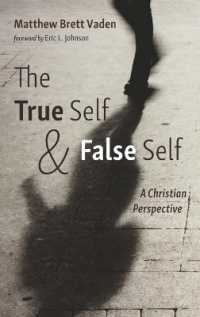- ホーム
- > 洋書
- > 英文書
- > Cinema / Film
Full Description
Ever since motion pictures first landed on screen, there have been many key questions that the studios and movie watchers have tried to answer. What makes a movie an Oscar winner? How does one movie become a hit and another movie flop? Why do some films earn critical acclaim while other films become critical turkeys or bombs? How do audiences perceive film? What makes a movie resonate with a viewer? Are we unduly influenced by negative behaviors on screen? These questions have spurred debates, discussions, and many theories. Until the last two decades, however, it was quite rare to have the issues approached from a scientific viewpoint.
The Social Science of Cinema compiles research from such varied disciplines as psychology, economics, sociology, business, and communications to find the best empirical research being done on the movies, based on perspectives that many filmgoers have never considered. Essays explore such topics as the specific factors that influence whether movies make money, win awards, or flop; how our personality impacts on our viewing preferences; issues of gender inequity on screen; the relationship between visual perception and the way movies are edited; and many more. This book attempts the ultimate act of figuring out the mystery behind the movies - what makes them so memorable to us, what makes them this century's leading works of art, and how this art intersects with the business of making money.
Contents
Acknowledgements ; Dedication ; List of Contributors ; Introduction: Social Science of the Cinema: Fade In ; James C. Kaufman and Dean Keith Simonton ; Section One: The Creation ; 1. Writing for success: Screenplays and cinematic impact ; Dean Keith Simonton ; 2. Sell by date? Examining the shelf life and effects of female actors in popular films ; Stacy L. Smith, Amy Granados, Marc Choueiti and Katherine M. Pieper ; 3. Resolving the paradox of film music through a cognitive narrative approach to film comprehension ; Annabel Cohen ; Section Two: The Audience ; 4. What type of movie person are you? Understanding individual differences in film preferences and uses: A psychographic approach ; Tomas Chamorro-Premuzic, Andrea Kallias, and Anne Hsu ; 5. Film through the human visual system: Finding patterns and limits ; Jordan E. DeLong, Kaitlin L. Brunick, and James E. Cutting ; 6. Self and the cinematic experience in the age of electronic transmission ; Gerald C. Cupchik and Michelle C. Hilscher ; Section Three: The Production ; 7. The producer-director dyad: Managing the faultline between art and commerce ; Joris J. Ebbers, Nachoem M. Wijnberg, and Pawan V. Bhansing ; 8. Networks and rewards among Hollywood artists: Evidence for a social structural ordering of creativity ; Gino Cattani and Simone Ferriani ; 9. Strategic assets and performance across institutional environments ; Allegre L. Hadida ; Section Four: The Reception ; 10. Analyzing the Academy Awards: Factors associated with winning and when surprises occur ; Iain Pardoe and Dean Keith Simonton ; 11. Responses to and judgments of acting on film ; Thalia R. Goldstein ; 12. As good as it gets? Blockbusters and the inequality of box office results since 1950 ; Victor Fernandez-Blanco, Victor Ginsburgh, Juan Prieto-Rodriguez, and Sheila Weyers ; End Section ; 13. Social Science of the Cinema: Fade Out ; Joshua Butler and James C. Kaufman








